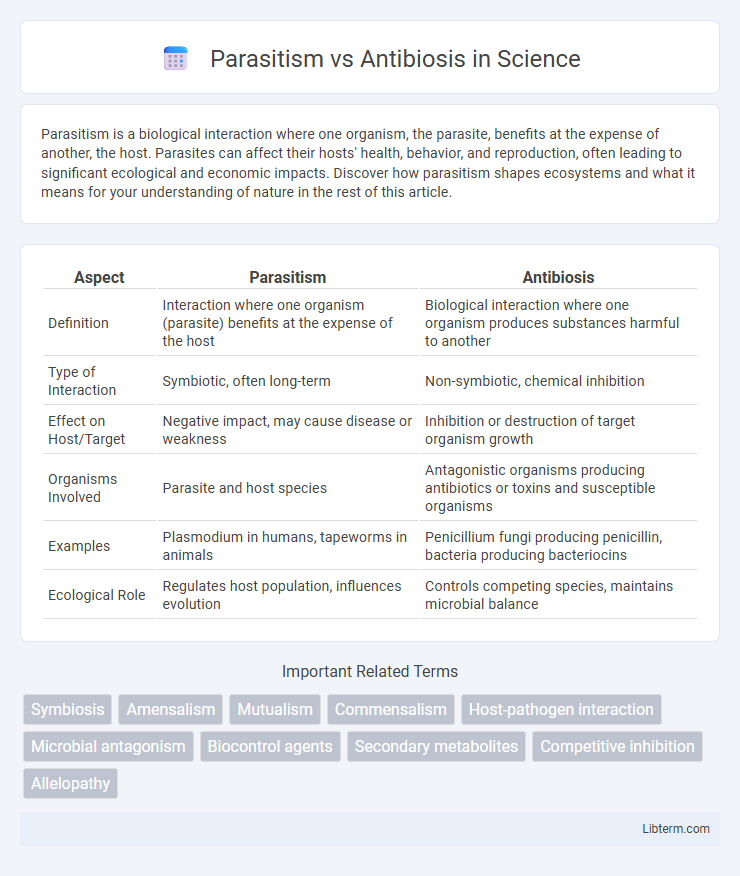Parasitism is a biological interaction where one organism, the parasite, benefits at the expense of another, the host. Parasites can affect their hosts' health, behavior, and reproduction, often leading to significant ecological and economic impacts. Discover how parasitism shapes ecosystems and what it means for your understanding of nature in the rest of this article.
Table of Comparison
| Aspect | Parasitism | Antibiosis |
|---|---|---|
| Definition | Interaction where one organism (parasite) benefits at the expense of the host | Biological interaction where one organism produces substances harmful to another |
| Type of Interaction | Symbiotic, often long-term | Non-symbiotic, chemical inhibition |
| Effect on Host/Target | Negative impact, may cause disease or weakness | Inhibition or destruction of target organism growth |
| Organisms Involved | Parasite and host species | Antagonistic organisms producing antibiotics or toxins and susceptible organisms |
| Examples | Plasmodium in humans, tapeworms in animals | Penicillium fungi producing penicillin, bacteria producing bacteriocins |
| Ecological Role | Regulates host population, influences evolution | Controls competing species, maintains microbial balance |
Introduction to Parasitism and Antibiosis
Parasitism involves one organism, the parasite, deriving nutrients at the expense of a host, often causing harm but rarely immediate death. Antibiosis describes a biological interaction where one organism produces metabolites that are detrimental to another, commonly observed in antibiotic-producing microbes inhibiting competitors. Both interactions play crucial roles in ecological balance and microbial population dynamics.
Defining Parasitism: Concepts and Examples
Parasitism is a biological relationship where one organism, the parasite, benefits at the expense of another organism, the host, often causing harm without immediate lethality. Common examples include tapeworms living in the intestines of mammals and mistletoe extracting nutrients from host trees. This interaction contrasts with antibiosis, where one organism produces biochemicals that inhibit or destroy another species, exemplified by antibiotic-producing bacteria suppressing pathogens.
Understanding Antibiosis: Mechanisms and Cases
Antibiosis involves the production of biochemical substances by one organism that inhibit or destroy another, commonly observed in microorganisms like bacteria and fungi. Key mechanisms include the secretion of antibiotics, enzymes, or toxic metabolites that target cellular processes in competing species, exemplified by Penicillium fungi producing penicillin to inhibit bacterial growth. Notable cases of antibiosis highlight its role in natural microbial competition and its application in medicine, agriculture, and biocontrol strategies to manage pathogens and pests effectively.
Key Differences Between Parasitism and Antibiosis
Parasitism involves one organism (the parasite) living on or inside another organism (the host), deriving nutrients at the host's expense without immediate death, while antibiosis refers to the production of biochemical substances by one microorganism that inhibit or kill another microorganism. Parasitism typically affects multicellular hosts in ecosystems, causing diseases or weakening the host, whereas antibiosis is commonly observed in microbial interactions, such as bacteria producing antibiotics to suppress competing microbes. The key difference lies in the direct physical association in parasitism versus the chemical inhibition in antibiosis.
Types of Parasitic Relationships
Parasitic relationships include ectoparasitism, where parasites live on the host's surface, and endoparasitism, involving internal habitation within the host. Facultative parasites can survive independently but exploit hosts opportunistically, while obligate parasites rely entirely on their hosts for survival. Social parasitism involves one species exploiting the social behavior of another, often found in insects like ants and bees.
Forms and Agents of Antibiosis
Antibiosis involves the production of bioactive substances by organisms, primarily bacteria and fungi, that inhibit or destroy competing species through antibiotics, bacteriocins, or antifungal compounds. Common forms of antibiosis include the secretion of enzymes, toxins, or secondary metabolites that interfere with cell wall synthesis or protein production in target organisms. This form of biological interaction contrasts with parasitism by directly affecting the survival or growth of competing microbes rather than relying on a host for nutrients.
Ecological Impacts of Parasitism
Parasitism significantly influences ecosystem dynamics by regulating host population sizes and promoting biodiversity through natural selection pressures. Parasites can alter community structure by affecting host behavior, reproductive success, and survival rates, thereby impacting food web interactions and energy flow. These ecological impacts contribute to maintaining balanced ecosystems and driving evolutionary adaptations among both hosts and parasites.
Ecological Roles of Antibiosis
Antibiosis plays a crucial ecological role by inhibiting the growth of harmful microorganisms, thereby maintaining microbial balance in ecosystems and protecting plants from pathogenic infections. This interaction affects nutrient cycling and promotes biodiversity by suppressing competitors and pathogens in soil and aquatic environments. The production of antibiotics by certain microbes is vital for disease control and contributes to natural biocontrol strategies in agriculture.
Medical and Agricultural Significance
Parasitism involves one organism benefiting at the expense of a host, often causing diseases in humans, animals, and crops, making it crucial in medical and agricultural pest management. Antibiosis is a biological interaction where one organism produces substances harmful to another, widely utilized in medicine through antibiotics to combat bacterial infections and in agriculture to suppress plant pathogens. Understanding these mechanisms enhances development of targeted therapies and sustainable crop protection strategies, reducing reliance on chemical pesticides and improving health outcomes.
Conclusion: Comparing Parasitism and Antibiosis
Parasitism involves one organism benefiting at the expense of another, often leading to host harm, while antibiosis refers to one organism producing substances that inhibit or kill another, typically used as a biological control mechanism. Both interactions impact ecological balances, with parasitism directly exploiting host resources and antibiosis reducing competitor populations through chemical means. Understanding these differences is crucial for applications in agriculture, medicine, and environmental management.
Parasitism Infographic

 libterm.com
libterm.com